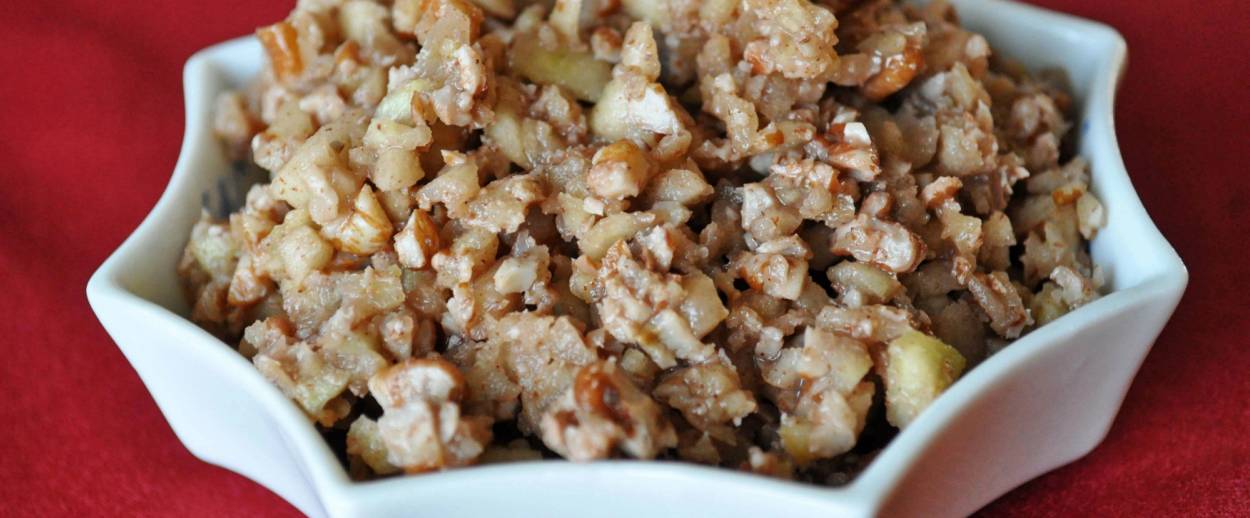For African-American Jews, the History’s in the Charoset
To create a charoset dish that holds meaning for African-American Jews, try including ingredients that are derived from crops of the transatlantic slave trade




Passover is just around the corner, and Jews all over the world are preparing to undergo all the motions of remembering that one time, three thousand years ago when we were slaves for a little bit, then got freedom, vindication, reparations (in the form of Egyptian gold, silver, and jewelry), and—following a 40-year interlude—a country.
For African-American Jews, however, Passover feels evermore real; tangible.
For us, the Seder plate isn’t something symbolic of an event that happened to “ancestors” a long, long time ago in a country far, far away. It’s about experiences that happened to family—our grandparents, great-grandparents, great-great grandparents—of whom we own photographs and maybe even have had the privilege of actually knowing, in the country we still actually live in.
“If the Holy One, Blessed is He,” reads the haggadah, “Had not freed us, then we, our children, and our children’s children, would still be slaves.”
This passage states the obvious—that the Jews would still be enslaved in Egypt were it not for God’s intervention. But it also tells us that even if the Egyptians had freed us in their own right, the Jews would have been stigmatized in the eyes of the Egyptians (and the world), as having been slaves who should be beholden to the Egyptians for the privilege of freedom. It would be a freedom that, at any given whim, could be presumably revoked at the Egyptians’s leisure.
Clearly, this has a particular resonance for African Americans, whose history can been distilled into three time periods in the public consciousness: the present-day, the Civil Rights era, and slavery. A freedom which can be revoked at any time? Do the repeals and attempted repeals of the Voter Registration Act or Affirmative Action sound familiar to anyone? So many aspects of the African-American experience post-slavery illustrate how miraculous the Jewish Exodus was.
The Jewish people did not have to endure struggles for citizenship, voting rights, or against Jim Crow laws. There was no need for a Civil Rights Movement. No generational wealth disparity, racial profiling, or disproportionate incarceration rates due to discriminatory crime bills. The Jewish People went from being slaves one day to being completely utterly free the next, with none of the aftermath that “real world” slavery to freedom entails.
Because of this, the celebration of Passover is more than just window dressing for African-American Jews, and some of us reflect this on our Seder plates.
Seder plates across the Jewish world exhibit variety in many different way, but no one aspect showcases regional or ethnic diversity as much as the charoset recipe. Meant to represent the mortar from which the Jews formed their bricks in Egypt, the traditional (read: Ashkenormative) recipe for charoset is apples, red wine, cinnamon, and walnuts or almonds. But that is just the tip of the charoset recipe iceberg.
The Jews of Gibraltar, for example, actually use ground up brick dust in their charoset. There is a Persian recipe for charoset which uses forty different ingredients—one for each year in the desert. Charoset from more tropical regions include fruits like dates and bananas.
And then there is the African-American charoset, consisting of molasses or brown sugar, figs, pecans, cocoa powder, rum or white wine. In order to prepare for a more African-American-centric Seder plate this past year, I altered Michael Twitty’s original recipe of molasses and pecans to include the fruit and alcohol ingredient that many other recipes contain (for, you know, guests who are allergic to nuts and don’t really want to slurp down molasses all night long).
Twitty’s recipe—in fact, the entire Seder plate he presents—is an homage to and a blending of the Jewish and African-American slavery experiences; he marries Jewish symbolism with African-American foods of equal resonance. Cocoa, figs, pecans, and sugar cane (from which brown sugar, molasses, and rum are all derived) were all prominent slave crops of the transatlantic slave trade. What better ingredients to create a dish representative of slave labor with meaning for African-American Jews?
There’s no need for “symbolism” in this charoset because… it’s already composed of actual blood and sweat and tears. Of human trafficking and shattered families. For African Americans, Passover is just as joyous as it is for any other family. It’s also a lot more real.
MaNishtana is the pseudonym of Shais Rishon, an Orthodox African-American Jewish writer, speaker, rabbi, and author of Thoughts From A Unicorn. His latest book is Ariel Samson, Freelance Rabbi.